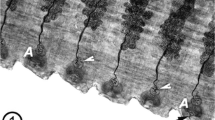Summary
The paired copulatory stylets of the hermaphroditicMicrophthalmus cf.listensis are hard cone-shaped tubes with a syringe-like distal opening and a cuff-like lower edge and surround the external openings of the two ejaculatory ducts. They each lie in a deeply invaginated epidermal fold and are attached basally to an elongated muscle bulb, which is composed of a number of disc-like muscle cells. A prominent gland is situated behind the stylets. Transfer of sperm into the partner occurs probably by mechanical hypodermal injection. Hereby, the epidermal folds are protruded as small sacks, pulling out the stylets. The development of the entire male genital apparatus occurs in autumn when the animals have about 16 setigerous segments. During this differentiation, two elongated papillae arise. They consist of various well defined cells, some of which border a central ciliated lumen. The stylet tubes arise by transformation of the at first normal cuticle of these papillae into a hard electron-dense wall.
Zusammenfassung
Die beiden paarigen Kopulationsstilette des zwittrigenMicrophthalmus cf.listensis sind feste, tütenförmige Röhren mit einer spitzen distalen Öffnung und einer manschettenförmigen unteren Kante. Sie liegen in je einer tief in den Körper hineinziehenden Epidermisfalte und umgeben die Endabschnitte der beiden Ductus ejaculatorii. Basal sind sie an je einem länglichen Muskelkörper befestigt, der aus scheibenförmigen Elementen zusammengesetzt ist. Hinter dem Stilett befindet sich eine Drüse. Das Sperma wird wahrscheinlich mechanisch hypodermal in den Geschlechtspartner injiziert. Die Epidermisfalten sind hierbei sackförmig ausgestülpt und die Stilette dabei nach außen gezogen. Die Entwicklung des gesamten männlichen Geschlechtsapparates erfolgt im Herbst, wenn die Tiere ungefähr 16 Borstensegmente besitzen. Hierbei bilden sich im 3. Borstensegment zwei längliche Papillen. Sie bestehen aus verschiedenen, gut zu unterscheidenden Zellen, von denen einige um ein zentrales bewimpertes Lumen angeordnet sind. Durch Umwandlung der zunächst normalen Kutikula dieser Papille zu einer elektronendichten festen Wand entsteht die Stilettröhre.
Similar content being viewed by others
References
Adiyodi, K.G., Adiyodi, R.G.: Morphology and cytology of the accessory sex glands in invertebrates. Int. Rev. Cytol.43, 353–402 (1975)
Aiyar, R.G., Alikunhi, K.H.: On some archiannelids of the Madras Coast. Proc. Nat. Inst. Sci. India10, 114–140 (1944)
Alikunhi, K.H.: A new hermaphrodite species ofMicrophthalmus (Polychaeta Hesionidae) from the sandy beach, Madras. J. Roy. Asiat. Soc., Sci.14, 17–25 (1948)
Ax, P.: Das Fortpflanzungsverhalten vonTrilobodrilus (Archiannelida, Dinophilidae). Mar. Biol.1, 330–335 (1968)
Bobretzky, N.: Zur Lehre über die Fortpflanzungsorgane der Anneliden [in Russian]. Kiev Odschest. Est. Zap.6, 61–86 (1880)
Du Bois-Reymond Marcus, E.: Further archiannelids from Brazil. Comun. Zool. Mus. Hist. Nat. Montevideo48, Vol. II, 1–17 (1948)
Brinkhurst, R.O., Jamieson, G.M.: Aquatic Oligochaeta of the world, pp. 860. Edinburgh: Oliver and Boyd 1971
Crezée, M.:Pamtomella rubra Rieger and Ott, an amphiatlantic acoel turbellarian. Cah. Biol. Mar.19, 1–9 (1978)
Doe, D.A.: The proboscis hooks in Karkinorhynchidae and Gnathorhynchidae (Turbellaria, Kalyptorhynchia) as basement membrane or intracellular specializations. Zool. Scr.5, 105–115 (1976)
Doe, D.A.: Finestructure of “cuticular” structures in Platyhelminthes. Am. Zool.17 (in press, 1977)
Ermak, T.H., Eakin, R.M.: Fine structure of the cerebral and pygidial ocelli inChone ecaudata (Polychaeta: Sabellidae). J. Ultrastruct. Res.54, 243–260 (1976)
Haswell, W.A.: On a new histriobdellid. Quart. J. Microsc. Sci.43, N.S., 299–335 (1900)
Hempelmann, F.: Die Geschlechtsorgane und Zellen vonSaccocirrus. Zoologica (Stuttgart)26, 249–304 (1912)
Jägersten, G.: Über den Bau des Kopulationsapparates und den Kopulationsmechanismus beiDinophilus. Zool. Bidr. Uppsala22, 61–86 (1944)
Jennings, J.B., Gelder, S.R.: Feeding and digestion inDinophilus gyrociliatus (Annelida: Archiannelida). J. Zool. (Lond.)158, 441–451 (1969)
Jouin, C.: Étude de quelques archiannélides des côtes d'Afrique du Sud; description deSaccocirrus heterochaetus n.sp. (Archiannélide, Saccocirridae). Cah. Biol. Mar.16, 97–110 (1975)
Lang, K.: A contribution to the morphology ofStratiodrilus platensis Cordero (Histriobdellidae). Ark. Zool.42 A, 23, 1–30 (1950)
Mainitz, M.: The fine structure of the stylet apparatus in Gnathostomulida Scleroperalia and its relationship to turbellarian stylets. Acta Zool. Fenn., Vol. 154, The Alex. Luther Cent. Symp. Turbellaria (T.G. Karling, M. Meinander, eds.), pp. 163–174 (1977)
Rieger, R.M.: The relationship of character variability and morphological complexity in copulatory structures of Turbellaria-Macrostomida and-Haplopharyngida. In: The meiofauna species in time and space (W. Sterrer, P. Ax, eds.). Mikrofauna Meeresboden61, 197–216 (1977)
Rieger, R.M., Doe, D.A.: The proboscis armature of Turbellaria-Kalyptorhynchia, a derivative of the basement lamina? Zool. Scr.4, 25–32 (1975)
Rieger, R.M., Rieger, G.E.: Fine structure of the pharymgeal bulb inTrilobodrilus and its phylogenetic significance within Archiannelida. Tissue & Cell7 267–279 (1975)
Rieger, R.M., Ruppert, E.: Resin embedment of quantitative meiofauna samples for structural and ecological studies.-Description and application. Mar. Biol.46, 223–235 (1978)
Schmidt, P., Westheide, W.:Dinophilus gyrociliatus (Polychaeta). Nahrungsaufnahme und Fortpflanzung. Encycl. Cinemat. E 1750, Begleitveröffentl., S. 1–16 (1972)
Schroeder, P.C., Hermans, C.O.: Annelida: Polychaeta. In: Reproduction of Marine Invertebrates III (A.C. Giese, J.S. Pearse, eds.), pp. 213. New York-San Francisco-London: Academic Press 1975
Shearer, C.: On the anatomy ofHistriobdella homari. Quart. J. Microsc. Sci.55, 287–359 (1910)
Tilney, L.G.: Origin and continuity of microtubules. In: Origin and continuity of cell organelles (J. Reinert, H. Ursprung, eds.). Results and problems in cell differentiation, Vol. II pp. 222–260. Berlin-Heidelberg-New York: Springer 1971
Traut, W.: Über die Kopulation beiDinophilus gyrociliatus (Archiannelida). Zool. Anz.177, 402–411 (1966)
Welsch, U.: Über den Feinbau der Chorda dorsalis vonBranchiostoma lanceolatum. Z. Zellforsch.87, 69–81 (1968)
Westheide, W.: Monograhie der GattungenHesionides Friedrich undMicrophthalmus Mecznikow (Polychaeta, Hesionidae). Ein Beitrag zur Organisation und Biologie psammobionter Polychaeten. Z. Morph. Tiere61, 1–159 (1967)
Westheide, W.: Zwei neue interstitielleMicrophthalmus-Arten (Polychaeta) von den Bermudas. Mikrofauna Meeresboden14, 1–16 (1973)
Westheide, W.: Interstitielle Polychaeten aus brasilianischen Sandstränden. Mikrofauna Meeresboden31, 1–16 (1974)
Westheide, W.: The geographical distribution of interstitial polychaetes. In: The meiofauna species in time and space (W. Sterrer, P. Ax, eds.). Mikrofauna Meeresboden61, 287–302 (1977)
Westheide, W., Rieger, R.M.: Cuticle ultrastructure of hesionid polychaetes (Annelida). Zoomorphologie91, 1–18 (1978)
Westheide, W., Schmidt, P.:Trilobodrilus axi (Polychaeta). Nahrungsaufnahme und Fortpflanzung. Encycl. Cinemat. E 1955, Begleitveröffentl., S. 1–12 (1974)
Author information
Authors and Affiliations
Rights and permissions
About this article
Cite this article
Westheide, W. Ultrastructure of the genital organs in interstitial polychaetes. Zoomorphologie 91, 101–118 (1978). https://doi.org/10.1007/BF00993855
Received:
Issue Date:
DOI: https://doi.org/10.1007/BF00993855




